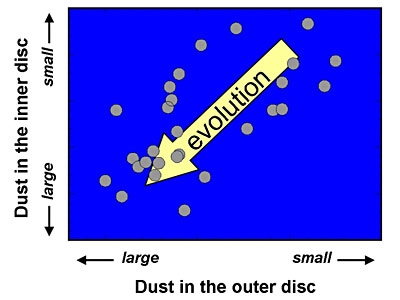
Planet formation: food for thought
Planet formation is a surprisingly homogeneous process that does not take place gradually from inside out, but that occurs everywhere at the same time in a proto-planetary disc, as Dave Lommen has discovered. He will obtain his doctorate this week based on his research into the dust around young stars observed using telescopes.
Spitzer Space Telescope
The sun and the eight planets in our solar system are now so old that there are few opportunities of learning something about their origin. So astronomers examine young stars that are similar to our sun, but that saw first light 'only' a million years ago. Such young stars are surrounded by a disc of dust, a so-called protoplanetary disc in which planets may form. Astronomers have so far assumed that the warm inner parts in the area close to the central star and the cold outer parts of the disc develop independently of one another. Recent observations using the Spitzer Space Telescope and ratio telescopes in the US and Australia have shown that this is not the case.
Radio telescopes
‘The strength of our work is primarily in the complementary nature of the telescopes,' says Lommen, 'because you can get different information for every object using different telescopes.' The Spitzer Space Telescope observes in infrared, which allows the hot dust around a young star to be charted. Spitzer is particularly sensitive to dust particles the size of sand and soot. Radio telescopes on the contrary look at longer wavelengths and are mainly suitable for observing the cold outer areas of a protoplanetary disc. They make it possible to see pebbles and boulders. 'Using the Spitzer we can look at areas where planets such as Venus or Earth originate,' Lommen continues, 'while with radio telescopes we mainly search for planets at the outer edge of the disc.'

Simultaneous
Lommen ande his colleagues examined the dust around a number of young stars. The models predicted that planet formation takes place in two steps: planets form first in the inner disc and only later in the outer disc. Young stars with the most dust in the inner disc turn out to have the biggest pebbles in the outer areas. 'It's a remarkable result,' Lommen explains, 'because this implies that planet formation doesn't take place gradually from the inside outwards, but can occur everywhere in the whole disc simultaneously.' It is important to look at a protoplanetary disc at precisely the right instance. Lommen: 'It is impossible to observe developing planets when the dust particles have coagulated to form boulders of larget than about a metre in size. The planets may then only be seen again when they have formed completely.'
Links
PhD defence: 23 April
Dave Lommen, The first steps of planet formation – Studying grain growth with millimetre interferometers
Supervisor: Profesor E.F. van Dishoeck
Co-supervisors: Dr C.M. Wright and Dr H.J. van Langevelde
Photo: An artist's impression of a thick disc of dust and gas around a young star. It is in such discs that planets are formed. NASA/JPL-Caltech.
(21 April 2009)
